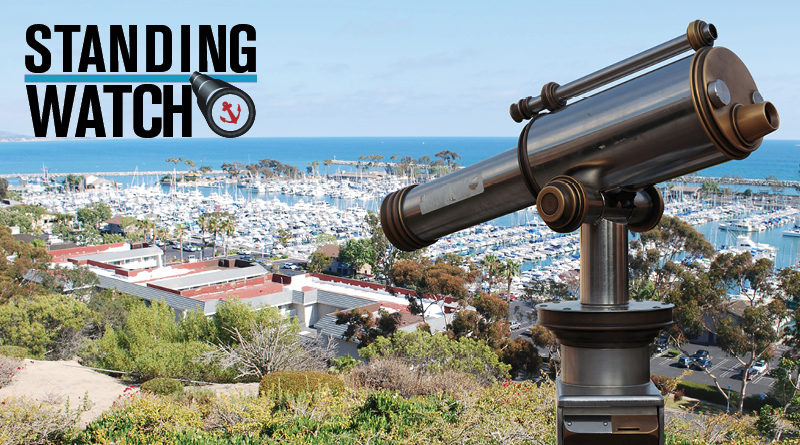Sea Lions and Boaters: Solutions for Co-Existence?
An illegal measure to deter sea lions was recently discovered in Newport Beach. How can pinnipeds and humans safely live together?
SOUTHERN CALIFORNIA — A set of floating docks armed with sea lion deterrents were the subject of two articles within The Log this summer, including a cover story in our Aug. 24-Sept. 6 issue. The deterrents were initially a set of nails used as stakes along the edges of the docks. The floating docks, located in Newport Beach Harbor, were later altered after city officials declared the use of staked nails to deter sea lions was illegal. The alteration may or may not be consistent with local or federal policy, but the larger question is how can boaters consistently co-exist with sea lions without resorting to illegal deterrents?
Our previous two stories on this issue listed what sorts of deterrents were considered illegal, including sharp object and live ammunition.
Boaters, no doubt, want to navigate through local waterways without crossing paths with sea lions. As cute as they might appear from afar, it is understandable to not want a sea lion to jump aboard your vessel. The loud barks at night might prove to be a nuisance for some, just the same.
The National Oceanic and Atmospheric Administration (NOAA) published, in November 2015, a set of guidelines of what boaters or other private property owners should and should not do when it comes to defending against sea lions.
Taking the wrong action could result in the boat or property owner defending him or herself against punishment in court.
“Regardless of method or intent, the property owner or fisher may be subject to prosecution should a marine mammal be seriously injured or killed as a result of deterrence efforts for the protection of property, gear or catch.
Co-existing with wildlife, of course, is a natural element of boating. Oceans, lakes and rivers are obviously homes for a wide variety of marine life and habitats. NOAA might have a list of things one cannot do with sea lions, but what are some techniques boaters and harbor professionals can implement to protect boater property without harming the local pinniped population?
Oceanside
The sea lion population at Oceanside Harbor reportedly proliferated between 2011 and 2012. Boaters, in a news report published by the San Diego Union-Tribune in August 2012, complained about finding sea lion slime and slobber on or around their vessels. The substances were either difficult to clean or left behind a strong stench, the boaters continued.
Oceanside City Hall appears to be proactive in addressing the harbor’s pinniped population. A page on the city’s website cautions locals of what to do if they come into contact with sea lions.
“Please don’t approach these animals,” a section of the city’s website on seals and sea lions stated. “They can be very territorial and they bite! If you see one on the beach, please call the lifeguard service closest to your city. You should remain a safe distance from them at all times, and leave them alone. Keep in mind they have very sharp teeth and may bite if cornered or harassed.”
Sea lions in Oceanside Harbor have been spotted on a floating dock just off of North Harbor Drive and near the city’s harbor department offices, which raises the question of whether government officials should proactively establish an area where pinnipeds can congregate, similar to the Sea Lion Center at Pier 39 in San Francisco.
Redondo Beach Harbor/King Harbor
The sea lion population also became the talk of the town at Redondo Beach’s King Harbor in 2015. Redondo Beach, like Oceanside, also set up a floating dock for the local pinniped population. Tarsan Standup, a local paddleboard company, recruited volunteers and created a fundraising campaign to assist Redondo Beach’s sea lion population.
Dana Point Harbor
O.C. Parks, which operates Dana Point Harbor, tried various techniques to keep sea lions off certain docks and slips. County officials installed several air dancers on docks in 2016, hoping the marketing contraption would scare sea lions away. The air dancers became less effective over time, county officials confessed; they later looked into combining deterrent measures.
Other Measures?
Barriers with rollers, snow fencing, white netting, swim step protectors, various types of noise makers, flags, balloons, pinwheels, streamers and sprayers are among the creative deterrents approved by NOAA.
Guard dogs, firearms, spear guns, harpoons, nail studded bats/poles/clubs, hammers, tainted baits, poisons and various sharp objects are among the items prohibited by NOAA as a sea lion deterrent.



I’ve come to the realization that our floating Sea Lion Island is beginning to work. It provides a location where Sea Lions can congregate without any attempts to deter them. We have required our Kayak and Paddleboard Rental Companies to instruct their customers to stay clear of this floating platform and to not bother any sea life. I’m not certain this is a permanent solution, but for now it seems to be working. As an added plus, we have many tourists that now come to this location (on land) and take pictures.